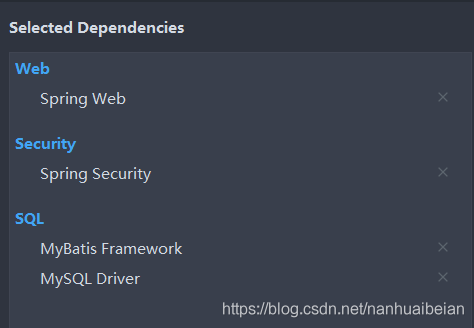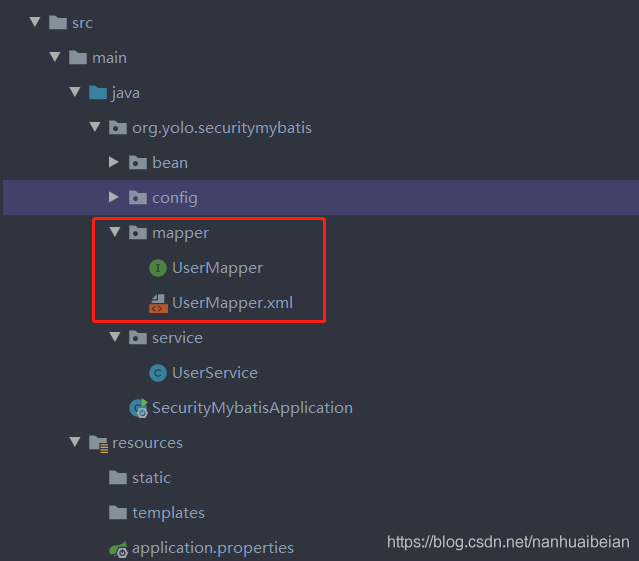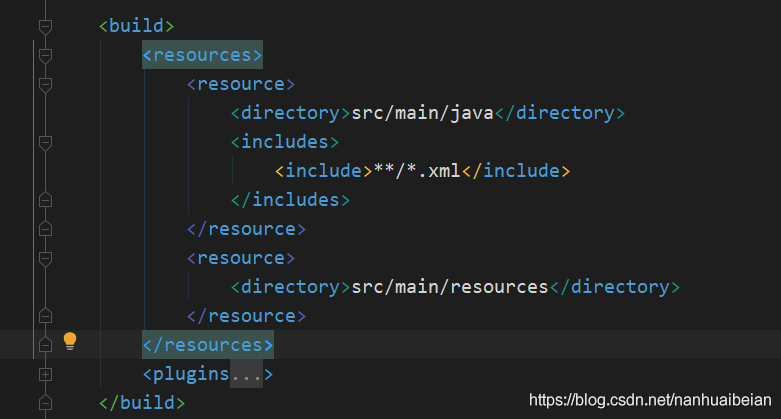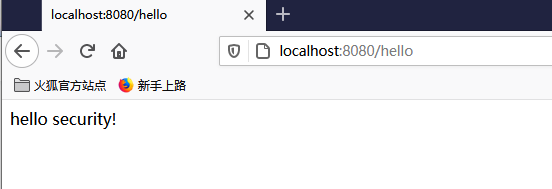一、前期配置
1. 加入依赖

<dependency>
<groupId>com.alibaba</groupId>
<artifactId>druid-spring-boot-starter</artifactId>
<version>1.1.10</version>
</dependency>
<dependency>
<groupId>mysql</groupId>
<artifactId>mysql-connector-java</artifactId>
<scope>runtime</scope>
<version>5.1.27</version>
</dependency>
这里选定的 mysql-connector-java 连接版本是 5.1.27,对应的 application.properties 为:
spring.datasource.url=jdbc:mysql://localhost:3306/yolo spring.datasource.type=com.alibaba.druid.pool.DruidDataSource spring.datasource.username=root spring.datasource.password=root
如果是 8.0以上版本则 application.properties 需要对于 spring.datasource.url 需要加入 serverTimezone
spring.datasource.username=root spring.datasource.password=root spring.datasource.type=com.alibaba.druid.pool.DruidDataSource spring.datasource.url=jdbc:mysql://localhost:3306/security?useUnicode=true&characterEncoding=UTF-8&serverTimezone=Asia/Shanghai
2. 数据库脚本
SET FOREIGN_KEY_CHECKS=0;
-- ----------------------------
-- Table structure for role
-- ----------------------------
DROP TABLE IF EXISTS `role`;
CREATE TABLE `role` (
`id` int(11) NOT NULL AUTO_INCREMENT,
`name` varchar(32) DEFAULT NULL,
`nameZh` varchar(32) DEFAULT NULL,
PRIMARY KEY (`id`)
) ENGINE=InnoDB AUTO_INCREMENT=4 DEFAULT CHARSET=utf8;
-- ----------------------------
-- Records of role
-- ----------------------------
INSERT INTO `role` VALUES ('1', 'dba', '数据库管理员');
INSERT INTO `role` VALUES ('2', 'admin', '系统管理员');
INSERT INTO `role` VALUES ('3', 'user', '用户');
-- ----------------------------
-- Table structure for user
-- ----------------------------
DROP TABLE IF EXISTS `user`;
CREATE TABLE `user` (
`id` int(11) NOT NULL AUTO_INCREMENT,
`username` varchar(32) DEFAULT NULL,
`password` varchar(255) DEFAULT NULL,
`enabled` tinyint(1) DEFAULT NULL,
`locked` tinyint(1) DEFAULT NULL,
PRIMARY KEY (`id`)
) ENGINE=InnoDB AUTO_INCREMENT=4 DEFAULT CHARSET=utf8;
-- ----------------------------
-- Records of user
-- ----------------------------
INSERT INTO `user` VALUES ('1', 'root', '$2a$10$RMuFXGQ5AtH4wOvkUqyvuecpqUSeoxZYqilXzbz50dceRsga.WYiq', '1', '0');
INSERT INTO `user` VALUES ('2', 'admin', '$2a$10$RMuFXGQ5AtH4wOvkUqyvuecpqUSeoxZYqilXzbz50dceRsga.WYiq', '1', '0');
INSERT INTO `user` VALUES ('3', 'sang', '$2a$10$RMuFXGQ5AtH4wOvkUqyvuecpqUSeoxZYqilXzbz50dceRsga.WYiq', '1', '0');
-- ----------------------------
-- Table structure for user_role
-- ----------------------------
DROP TABLE IF EXISTS `user_role`;
CREATE TABLE `user_role` (
`id` int(11) NOT NULL AUTO_INCREMENT,
`uid` int(11) DEFAULT NULL,
`rid` int(11) DEFAULT NULL,
PRIMARY KEY (`id`)
) ENGINE=InnoDB AUTO_INCREMENT=5 DEFAULT CHARSET=utf8;
-- ----------------------------
-- Records of user_role
-- ----------------------------
INSERT INTO `user_role` VALUES ('1', '1', '1');
INSERT INTO `user_role` VALUES ('2', '1', '2');
INSERT INTO `user_role` VALUES ('3', '2', '2');
INSERT INTO `user_role` VALUES ('4', '3', '3');
SET FOREIGN_KEY_CHECKS=1;
二、定义实体类
1. 定义 User
实体类 User 需要实现 UserDetails 接口,因为每个人都可以定义 User 对象,但是每个人定义的 User对象不一样,这就造成每个人设置的属性不一样,当系统需要判定用户的登录状态时,因为用户名和密码的名称设置的五花八门,造成无法确定调用哪个
所以这里要求所有的实体类实现 UserDetails 接口,它就相当于一个规范定义了登录验证时需要的属性名称,所以的实体类都要符合这个规范。
public class User implements UserDetails {
private Integer id;
private String username;
private String password;
private Boolean enabled;
private Boolean locked;
private List<Role> roles;
public List<Role> getRoles() {
return roles;
}
public void setRoles(List<Role> roles) {
this.roles = roles;
}
public Integer getId() {
return id;
}
public void setId(Integer id) {
this.id = id;
}
@Override
public String getUsername() {
return username;
}
@Override
public boolean isAccountNonExpired() {
return true;
}
@Override
public boolean isAccountNonLocked() {
return !locked;
}
@Override
public boolean isCredentialsNonExpired() {
return true;
}
@Override
public boolean isEnabled() {
return enabled;
}
public void setUsername(String username) {
this.username = username;
}
@Override
public Collection<? extends GrantedAuthority> getAuthorities() {
List<SimpleGrantedAuthority> authorities = new ArrayList<>();
for (Role role : roles) {
authorities.add(new SimpleGrantedAuthority("ROLE_"+role.getName()));
}
return authorities;
}
@Override
public String getPassword() {
return password;
}
public void setPassword(String password) {
this.password = password;
}
public void setEnabled(Boolean enabled) {
this.enabled = enabled;
}
public void setLocked(Boolean locked) {
this.locked = locked;
}
}
(1) accountNonExpired、accountNonLocked、credentialsNonExpired、enabled 这四个属性分别用来描述用户的状态,表示账户是否没有过期、账户是否没有被锁定、密码是否没有过期、以及账户是否可用。
(2)roles 属性表示用户的角色,User 和 Role 是多对多关系,用一个 @ManyToMany 注解来描述。
(3)getAuthorities 方法返回用户的角色信息,我们在这个方法中把自己的 Role 稍微转化一下即可。
(1)这个集合是返回用户的所有角色,因为从数据库得到是 roles,但是需要的是一个集合形式的 getAuthorities,所以需要对其进行处理。
@Override
public Collection<? extends GrantedAuthority> getAuthorities() {
List<SimpleGrantedAuthority> authorities = new ArrayList<>();
for (Role role : roles) {
authorities.add(new SimpleGrantedAuthority("ROLE_"+role.getName()));
}
return authorities;
}
这里注意springsecurity 角色的认证有一个要求,必须是以 ROLE_ 开始的,否则会出现问题:
authorities.add(new SimpleGrantedAuthority("ROLE_"+role.getName()));
当然也可以在数据中添加用户时,就让用户以 ROLE_ 开始,这样就不用二次添加了
(2)另外需要注意这里的 isAccountNonLocked(),账户是否没有被锁定,数据库中存储的是:

所以这里是对 locked 取的反
@Override
public boolean isAccountNonLocked() {
return !locked;
}
2. 定义 Role
public class Role {
private Integer id;
private String name;
private String nameZh;
public Integer getId() {
return id;
}
public void setId(Integer id) {
this.id = id;
}
public String getName() {
return name;
}
public void setName(String name) {
this.name = name;
}
public String getNameZh() {
return nameZh;
}
public void setNameZh(String nameZh) {
this.nameZh = nameZh;
}
}
三、定义 Service
@Service
public class UserService implements UserDetailsService {
@Autowired
UserMapper userMapper;
@Override
public UserDetails loadUserByUsername(String username) throws UsernameNotFoundException {
User user = userMapper.loadUserByUsername(username);
if (user == null) {
throw new UsernameNotFoundException("用户不存在!");
}
user.setRoles(userMapper.getUserRolesById(user.getId()));
return user;
}
}
我们自己定义的 UserService 需要实现 UserDetailsService 接口,实现该接口,就要实现接口中的方法,也就是 loadUserByUsername ,这个方法的参数就是用户在登录的时候传入的用户名,根据用户名去查询用户信息(查出来之后,系统会自动进行密码比对)。
四、定义 Mapper
1. UserMapper
@Mapper
public interface UserMapper {
User loadUserByUsername(String username);
List<Role> getUserRolesById(Integer id);
}
2. UserMapper.xml
<?xml version="1.0" encoding="UTF-8" ?>
<!DOCTYPE mapper
PUBLIC "-//mybatis.org//DTD Mapper 3.0//EN"
"http://mybatis.org/dtd/mybatis-3-mapper.dtd">
<mapper namespace="org.javaboy.securitydb.mapper.UserMapper">
<select id="loadUserByUsername" resultType="org.yolo.securitymybatis.bean.User">
select * from user where username=#{username}
</select>
<select id="getUserRolesById" resultType="org.yolo.securitymybatis.bean.Role">
select * from role where id in (select rid from user_role where uid=#{id})
</select>
</mapper>
Mapper 的位置:

所以需要为其添加资源路径:资源配置路径添加到 pom 文件中
<resources>
<resource>
<directory>src/main/java</directory>
<includes>
<include>**/*.xml</include>
</includes>
</resource>
<resource>
<directory>src/main/resources</directory>
</resource>
</resources>

五、定义 SecurityConfig
@Configuration
public class SecurityConfig extends WebSecurityConfigurerAdapter {
@Autowired
UserService userService;
@Override
protected void configure(AuthenticationManagerBuilder auth) throws Exception {
auth.userDetailsService(userService);
}
@Bean
PasswordEncoder passwordEncoder() {
return new BCryptPasswordEncoder();
}
@Bean
RoleHierarchy roleHierarchy() {
RoleHierarchyImpl roleHierarchy = new RoleHierarchyImpl();
String hierarchy = "ROLE_dba > ROLE_admin \n ROLE_admin > ROLE_user";
roleHierarchy.setHierarchy(hierarchy);
return roleHierarchy;
}
@Override
protected void configure(HttpSecurity http) throws Exception {
http.authorizeRequests()
.antMatchers("/dba/**").hasRole("dba")
.antMatchers("/admin/**").hasRole("admin")
.antMatchers("/user/**").hasRole("user")
.anyRequest().authenticated()
.and()
.formLogin()
.permitAll()
.and()
.csrf().disable();
}
}
测试访问:成功

到此这篇关于一篇文章带你搞定 springsecurity基于数据库的认证(springsecurity整合mybatis)的文章就介绍到这了,更多相关springsecurity整合mybatis内容请搜索自学编程网以前的文章或继续浏览下面的相关文章希望大家以后多多支持自学编程网!

- 本文固定链接: https://zxbcw.cn/post/197418/
- 转载请注明:必须在正文中标注并保留原文链接
- QQ群: PHP高手阵营官方总群(344148542)
- QQ群: Yii2.0开发(304864863)
